Handset Charge vs Dock Charge vs Continuous Charge – Which Ceiling Hoist Charging Method is Best for me?
15 Minute Read
If you’re in the market for a new ceiling hoist and track installation, you might have questions about the type of ceiling hoist and charging method that will work best for you and your environment. Whilst it’s great to have many options, it can also be overwhelming to know which one to choose.
The questions we get asked a lot are “What is the difference between the ceiling hoist charging options?” and “Which ceiling hoist charging method is best for me?”
Here at Medaco, we think it’s important to give an honest comparison of the different methods, with everything you need to know, so the decision is easier for you.
Hopefully, after reading this, you’ll have a greater sense of which ceiling hoist charging method is the right choice for you.
Of course, if you still need advice and guidance, get in touch with Medaco and we can talk you through the different options to help you decide which is best for you.
Handset Charge (Wall Mounted Charge)
Care Staff charge handset charge hoists through the operational handset, by placing the handset in a wall-mounted charging station. The handset has charging connections on the back for charging through the charging station.
The handset charge method is becoming popular in all care settings as more people are made aware of them. Most care environments suit this charging method, such as care homes, schools and hospitals. It’s an easy to use charge method which is suitable for most budgets, both for the initial cost of the installation and ongoing repair costs.
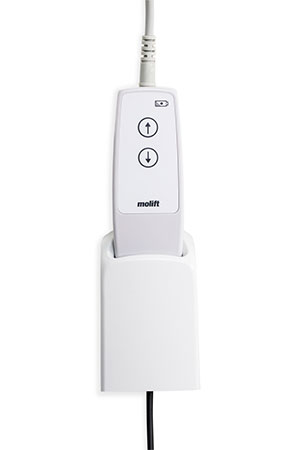
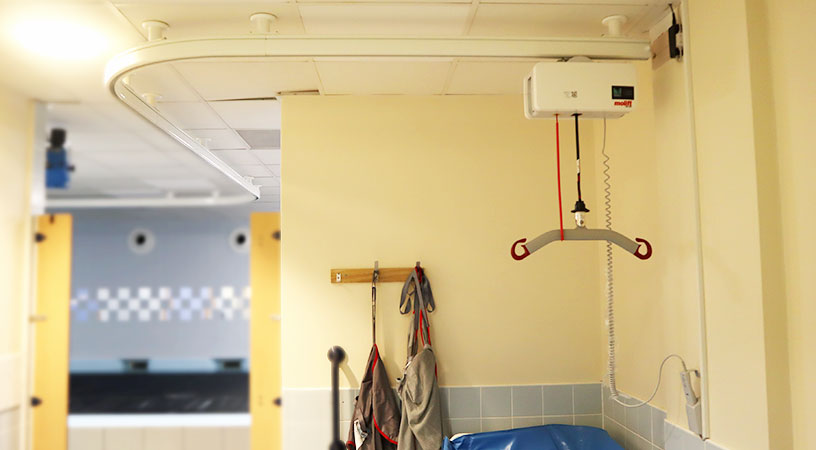
Handset charge ceiling hoists are also suitable for wet environments because the charging contacts are small and discreet, so at low risk of water damage. However, if you submerge the handset or operate it with wet hands, this will cause damage both to the operational buttons and the charging connections. The charging station can be placed at eye level, which has lower heat and humidity than at the ceiling level where the other charging methods are located.
Because the handset needs to be placed in a charging station, which needs to be mounted on the wall, this charge method isn’t suitable for rooms where the track doesn’t pass by or reach a wall, pillar, etc. This is where one of the other methods might be more suitable.
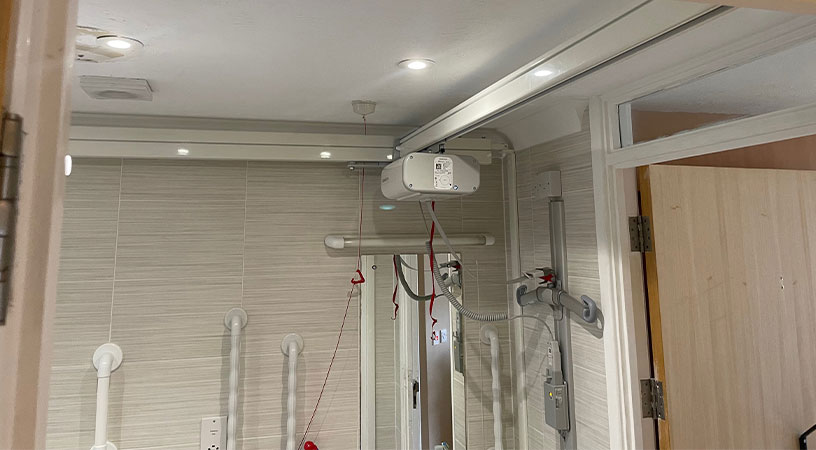
Advantages of Choosing Handset Charge
Disadvantages of Choosing Handset Charge
Dock Charge (End of Rail Charging)
A dock charge ceiling hoist uses a charging docking station mounted on the end of the track. To charge the hoist on a straight track, you simply move the hoist unit along the track slowly until it connects with the dock. To charge the hoist on an H system (X/Y tracking) staff need to move the hoist unit along to the end of the moving rail and then push the moving rail along to the end of the fixed rails.
Dock charge or end of rail charging hoists are suitable for many care environments and those with a smaller budget. Also suitable for rooms where the track doesn’t reach a wall for handset charge, for example, if the track is best placed in the middle of a school classroom.
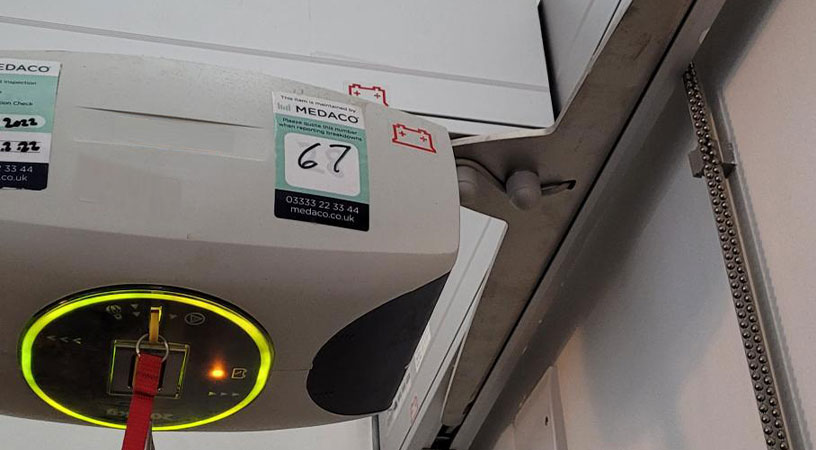
Because the dock has to be at the end of one of the rails, this charge method might not be suitable in smaller nursing homes; if room features, such as windows, door frames or wardrobes, impede the hoist charging area.
You can use dock charge hoists in wet environments as there is less surface metal on show than continuous charge options, so less chance of corrosion occurring quickly. However, there can still be issues with this charge method in these environments, as the charging dock is at the ceiling level where the heat and humidity rise.

Advantages of Choosing Dock Charge
Disadvantages of Choosing Dock Charge
Continuous Charge (In Rail Charging)
Continuous charge or in-rail charging (IRC), is where you can charge the hoist motor unit anywhere along the rail as the charging connections are within the track. During active lifting, the continuous charging system will ‘pause’ and then automatically re-activate charging when the hoist motor is stationary along the rail. Staff not putting the ceiling hoist back on charge is one of the common reasons for emergency call-outs, so this could be a solution if your staff tell you they don’t have time to put the hoist back on charge.
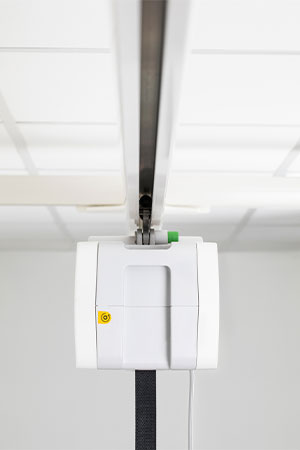
A continuous charge hoist is best suited for busy, high use areas such as hospitals and schools. We commonly see this type of charge used in SEND schools where staff need to make many lifts within a classroom. You can also choose a continuous charge if the layout or shape of the room can’t accommodate a handset charge or dock charge method, but this is uncommon.
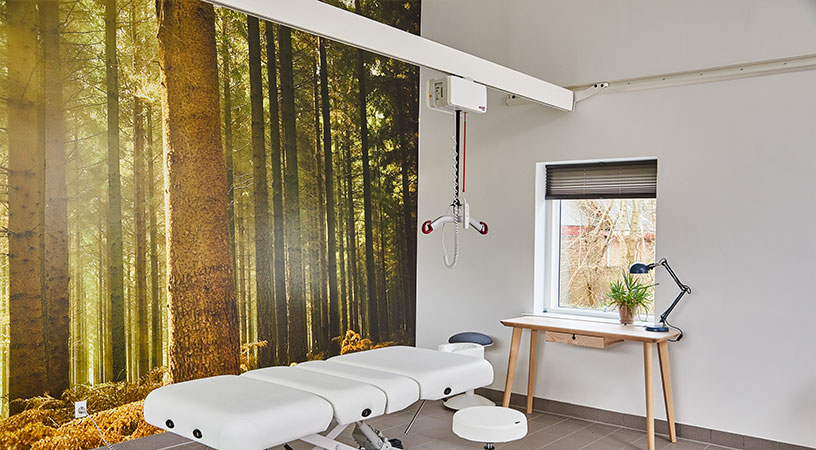
This charging method isn’t the best-suited solution for wet environments, as the charging connections within the rail corrode easily. This type of system can also be difficult with a complex layout that might need bends in the track, gates or turntables.
Advantages of Choosing Continuous Charge
Disadvantages of Choosing Continuous Charge
So, Which Ceiling Hoist Charge Method is Best for you?
One of the common causes of breakdowns for ceiling hoists is the batteries becoming depleted or flat, as it’s important to charge batteries regularly. When choosing a ceiling hoist charge method, you need to consider the environment it’s going to be used in, how staff will use the ceiling hoist, and what your budget is for ceiling hoists and tracks.
Most care environments with regular use of ceiling hoists and a smaller budget will benefit from a dock or handset charge ceiling hoist.
If you have maintenance teams that are happy to carry out minor repairs themselves, then handset charge would be the most suitable option.
Care environments with heavy use, such as Special Educational Needs Schools, might benefit from a continuous charge ceiling hoist if they have the extra budget for this charging method. If the budget is a constraint, then you might find dock or handset charge ceiling hoists more suitable. Medaco has many SEND School customers that use these two charge methods with no problems.
Medaco is a leading supplier of moving and handling equipment to schools, care homes and hospitals. We design, supply and install ceiling hoists and tracks ranging from simple straight track and H systems (complete room covering) to complex layouts for different requirements.
If you’re interested in learning more, read this article on What Affects the Costs of Ceiling Hoist Installations.
If you’d like to talk to a ceiling hoist specialist, request a callback or schedule a meeting with our experts. We’d be happy to help you with your next ceiling hoist project.
You ask – We answer
This blog is from a new series focusing on ‘You ask – We answer’ where we aim to answer the hard-hitting questions our customers are asking. If you have a burning question you would like answered, just type it in the box below.
Interested in more articles like this? Sign up below to get notifications of new articles published.
If email isn’t your thing, follow us on our social channels for all the latest updates from Medaco.



